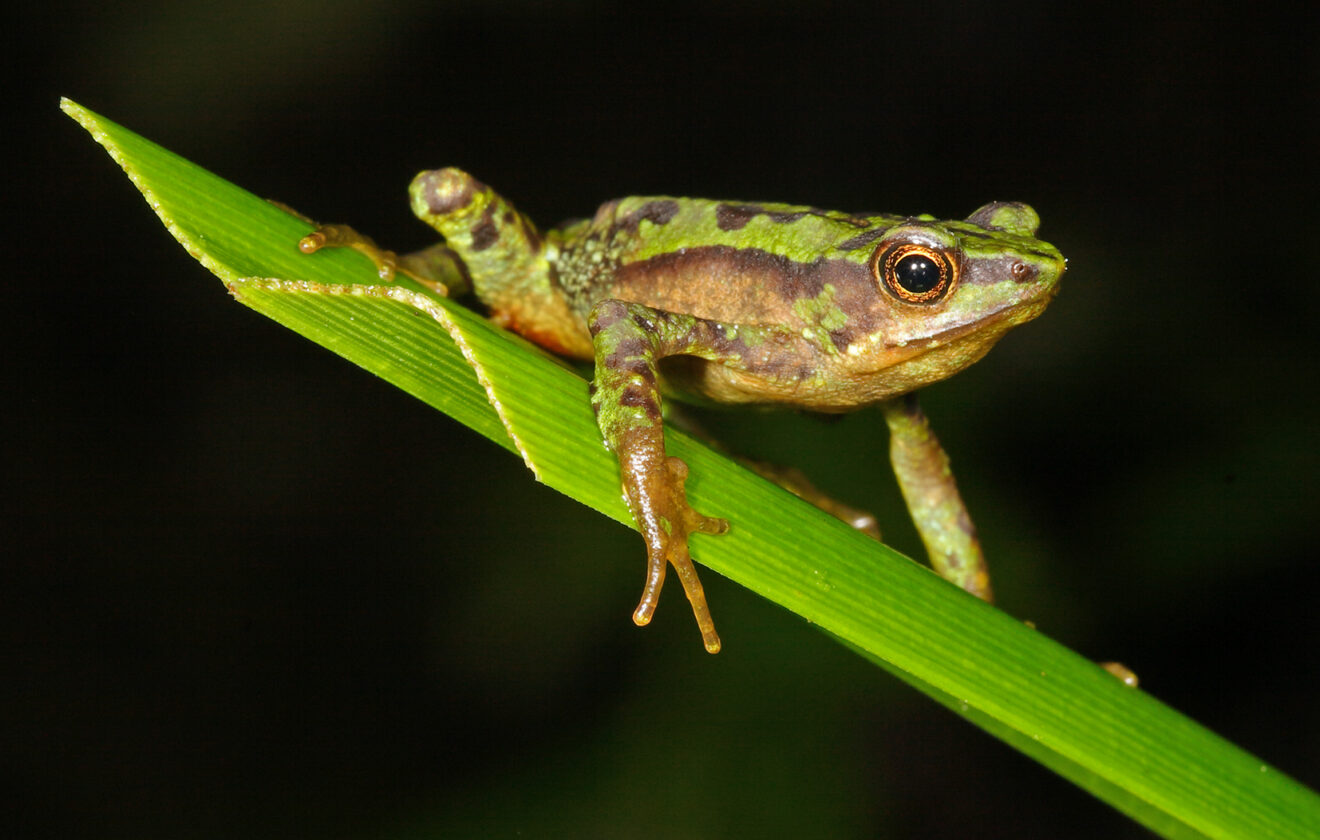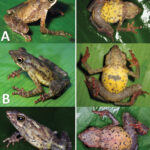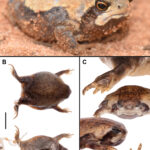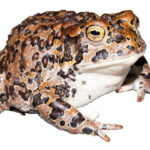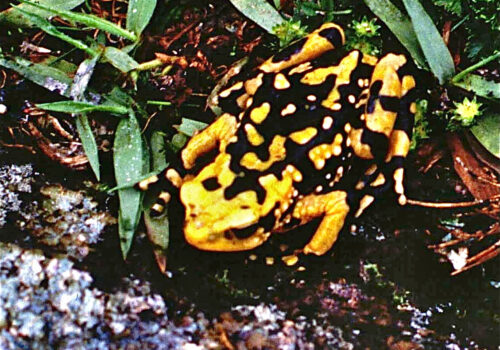- Atelopus Palmatus: Journey into the Life of a Vibrant Harlequin of the Amazon
Atelopus Palmatus: Journey into the Life of a Vibrant Harlequin of the Amazon#
Deep within the humid embrace of the Amazon rainforest, where sun-dappled foliage plays tricks on the eyes and moisture hangs heavy beneath dense canopies, a vivid splash of color and intrigue waits patiently on leaves and river rocks. Here, amidst hues of emerald and jade, lives a delicate yet resilient amphibian species that captures the imagination of herpetologists and nature enthusiasts alike—the Amazonian harlequin frog, known scientifically as Atelopus palmatus.
As its whimsical common name suggests, this frog adorns itself in striking patterns and extraordinary hues, reminiscent of an artist’s vivid brushstroke. Yet behind its enchanting colors lies a creature whose very existence tells a profound story of ecological interconnectedness, environmental sensitivity, and the urgent call to conservation.
Taxonomy and Classification#
The fascinating creature known formally as Atelopus palmatus belongs to the Bufonidae family, one of the most diverse and intriguing assemblages of amphibians known as true toads. Within this expansive classification, the genus Atelopus—commonly known as harlequin toads or frogs—stands out for both their striking color patterns and their troubling vulnerability.
Atelopus palmatus was first scientifically described by Georges Cuvier in 1829; since then, it has captured the attention of biologists worldwide. It shares its genus—a collection often vividly described as “jewels of the rainforest floor”—with other visually stunning yet highly endangered species of harlequin frogs, each with its distinct coloration patterns.
Natural Habitat#
Atelopus palmatus is a creature firmly rooted in aquatic ecosystems and riverside habitats, found predominantly in tropical rainforests of Brazil, Ecuador, Peru, and Colombia. Its existence depends intimately upon clean, gently flowing streams and nearby moist habitats, where shadows filter through the trees, creating mosaic patterns over fronds and stones alike.
A riverbank in the Amazonian basin offers the ideal home for the species. Here, amid soft beds of moss, moisture-seeped leaf litter, and slippery stones by clear forest streams, the Amazonian harlequin frog conducts its daily activities—concealed yet elegantly visible to observant eyes. The presence of Atelopus palmatus is often considered a reliable indicator of ecosystem health, reflecting the quality of water and the balance of biodiversity in its community.
Physical Characteristics#
The visual beauty of Atelopus palmatus is undeniable and profound. Adults typically measure between 25 and 40 mm in length, a modest size made remarkable by their stunning coloration. Their delicate yet agile bodies showcase bold contrasts—typically, vivid yellow, golden, orange, or emerald-green hues set dramatically against a velvety black background. These patterns serve as effective aposematic coloration—warning hues that indicate their toxicity to prospective predators.
The frog’s skin texture varies notably from slightly granular to smooth, a critical adaptation facilitating moisture retention and breathing through the skin. The limbs—their graceful extension evocative of an artistically carved puppet—display a distinctive webbing between the fingers and toes, an adaptation perfectly suited to their semi-aquatic lifestyle. This webbing aids not only in swimming but also in gripping slippery wet surfaces, ensuring nimble movement along riverbanks.
Behavior and Life Cycle#
Feeding Habits#
Quietly vigilant along stream edges, Atelopus palmatus carefully watches the bustling world of insects that swarm in the rainforest undergrowth. It is an opportunistic predator, skillfully snapping up small invertebrates, including ants, beetles, and spiders. A patient hunter, the frog waits motionlessly before swiftly lunging forward—a sudden act that occurs in a matter of milliseconds. Such lightning-fast movements are crucial in securing elusive prey and avoiding threats.
Breeding and Reproduction#
The lyrical symphony of courting male Atelopus echoes gently over forest streams, attracting potential mates that navigate their way carefully towards vocalizing suitors. Breeding seasons occur predominantly during the rainy season, when small streams swell with rainfall, increasing reproductive success.
Colorful males strategically station themselves in highly visible locations—perched atop rocks or standing resolutely on stream banks—to amplify their melodious advertisements. Once a female approaches, the male quickly engages her in amplexus, holding firmly as together they deposit strands of eggs into slow-moving portions of streams and shallow pools.
Larval development is rapid yet delicate. The tadpoles emerge mere days after egg deposition and enter a competitive aquatic environment fraught with opportunity and danger. From vulnerable larvae swimming gently amid stones and moss, they gradually metamorphose into tiny froglets, eventually climbing ashore to begin their terrestrial lives.
Defensive and Adaptive Behaviors#
The harlequin frog’s striking colors serve as clear signals of the potent toxins secreted through their skin glands. These toxic alkaloids deter most predators, granting the frogs an invaluable defensive advantage. Additionally, with their sensitive skin, these amphibians carefully select habitats that maintain optimal moisture and humidity levels—a survival strategy in their fluctuating rainforest environment.
Ecological Role#
Despite their small stature, Atelopus palmatus frogs fulfill essential ecological functions within their forest habitat. Their appetite for insects helps control insect populations, maintaining a delicate balance in their rainforest ecosystem. Conversely, they themselves provide potential prey—albeit selectively—to certain specialized predators equipped to handle their toxins, such as specific snake and bird species adapted to amphibian prey with toxic defenses.
Furthermore, these frogs represent vital bioindicators. Given their pronounced sensitivity to changes in water quality, habitat degradation, and climate conditions, declines in their populations signal changing environmental conditions long before other species are affected, highlighting circumstances that require attention from researchers and conservationists.
Threats and Conservation Status#
Unfortunately, the stunning beauty and ecological significance of Atelopus palmatus is matched only by its alarming vulnerability. Threatened by habitat destruction, water pollution, climate change, and the devastating chytrid fungal disease (Batrachochytrium dendrobatidis), its populations have experienced worrying declines.
The International Union for Conservation of Nature (IUCN) currently classifies Atelopus palmatus as Critically Endangered, indicating it faces an extremely high risk of extinction in the wild. Habitat fragmentation from agricultural expansion, logging roads penetrating pristine rainforests, and illegal mining activities profoundly disrupt and degrade their essential habitats. Additionally, changing climatic regimes—altering rainfall patterns and temperature—pose severe challenges to their reproductive cycles and survival.
Conservationists and scientists have mobilized numerous initiatives to protect this fragile species. These efforts include habitat restoration projects, captive breeding and reintroduction programs, and diligent monitoring of wild populations. Educational collaboration with local communities aims to foster greater understanding and sustainable land stewardship practices—steps critical for long-term survival.
Cultural and Scientific Significance#
The vibrant coloration and charismatic presence of Atelopus palmatus have not escaped notice within local cultures. Indigenous communities in the Amazon have long regarded these amphibians symbolically, sometimes associating their appearance or behavior with rainfall, fertility, and renewal. For some cultures, witnessing the harlequin frogs’ seasonal movements signals the onset of seasonal shifts, guiding essential agricultural practices.
Beyond cultural reverence, the scientific significance of Atelopus palmatus is profound. These frogs have provided unique insights into amphibian ecology, toxicology, and conservation biology. Research into their potent skin toxins holds potential medicinal applications, potentially offering new therapeutic avenues for pharmaceuticals, illustrating yet another reason why safeguarding their continued existence is critical.
Conclusion: Celebrating and Protecting a Fragile Treasure of the Amazon#
In the gently shifting shadows of tropical embrace, the Amazon harlequin frog quietly performs its daily rituals, offering inhabitants and visitors alike moments of extraordinary natural beauty and vital ecological insights. As delicate as it is captivating, this vibrant amphibian’s future rests in collective hands.
By deepening our understanding of Atelopus palmatus, embracing conservation actions, and spreading awareness, we can collaboratively ensure that its mesmerizing presence continues to grace tropical rainforest streams into future generations.
The deeper we journey into understanding and protecting creatures like Atelopus palmatus, the clearer it becomes—they are more than beautiful ornaments in nature’s tapestry; they are symbols of resilience, indicators of environmental health, and storytellers of ecosystems intertwined. Let their splash of color and whispered calls remind us of our shared responsibility to treasure and protect the intricate web of life.

